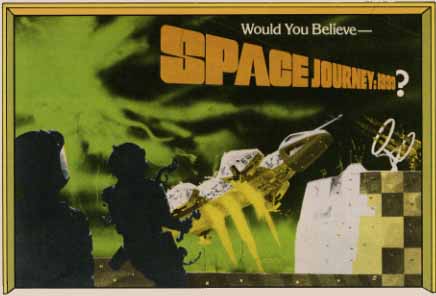|
When production ended so abruptly on the syndi-
cated TV series, Space: 1999, a number of fans
blamed the failure of the show on the many changes
made for the second season. But few fans know of
the drastic changes that were made on Space before
filming ever began.
|
By DAVID HIRSCH
Space Probe, Journey into Space,
Space Intruders andSpace Journey:
1999 were only a few of the trial titles
proposed for a 26 episode, half-hour
series that was being developed by the
Independent Television Corporation
around 1973. Although the premise of
the series called for the Moon to be
blasted out of Earth orbit, the initial
profile of the lunar base was totally dif-
ferent from the Moonbase Alpha seen in
each episode of Space: 1999.
The original proposal for the series
gave the appearance of being a spin-off
sequel to the UFO TV series developed
by co-producers and creators Gerry and
Sylvia Anderson in conjunction with
ITC Entertainment. Of course the UFO
connection was dropped from the for-
mat by the time the opening episode,
"Breakaway," was filmed.
Here are some of the major features
from that original proposal--some ap-
peared in the series with minor changes;
some underwent major revision; some
never made it into the final series.
Space Journey: 1999
By the turn of the next century, the |
nations of the world, as a defense
against the threat of alien attack, have
united to construct Moon City, a 20-
mile-square complex on the near side of
the Moon. Control of the operations of
Moon City comes from the Command-
er's Control Sector, located within in
hub of the wheel-like complex. Access
to the security-tight operations center is
down through a cylindrical tube, 30
yards in diameter. Only a computer con-
trolled Moonhopper can carry people
and equipment to and from the center.
Once inside the boarding tube airlock, a
person can only continue if he or she
knows the proper security code to punch
on the door lock and if their voice
matches the computer-logged voice
print.
Within the center, the Commander of
the city can monitor any area of the
complex from his office in the small end
of the wedge-shaped office/control
center. His personal computer, which
can only be used by the Commander, is
programmed to think like him. COM-
COM, the Commander's Computer, is
also programmed with his values and
sense of morality.
The Commander's office is attached
to the Control Room at the broad end of
the wedge in the same way John |
|
Koenig's office was to Main Mission, by
a sliding wall. The Control Room
receives constant information from the
Early Warning Tracking Stations out-
side Moon City. If an alien attack is im-
minent, then the Control Room can put
the appropriate sections on Battle Alert
in seconds.
For defense, Moon City has two types
of battlecraft. First, there is the high
speed, singel-seater Interceptor craft
equipped with space-to-space missiles.
Lunarmobiles with ground-to-ground
missiles go into action when UFOs land
on the lunar terrain. For non-defense
use, Moonships (the forerunner of the
Eagle Transporter)shuttle to and from
the Moon, while Moonhoppers and
Travel Tubes shuttle around the base.
Moonbuggies are for exploration on the
lunar surface.
Space: 1999
Once the series was expanded to a full
hour and the UFO-like format was
dropped (and the working title changed
to Space: 1999 ), Keith Wilson was hired
to design the visual appearance of the
series. Brian Johnson and Rudi Gern-
reich would later design the SFX models
and costumes, respectively.
Many of Wilson's designs were built
around the concept of immense size to
give the viewer the appearance of a huge
city, requiring many of the original sets
to be designed on a grand scale. The
Main Mission set retained its expansive
form to provide the same illusion of vast
space as the Engineering Deck of the
Enterprise did in Star Trek.
Among the interior sets first designed |

